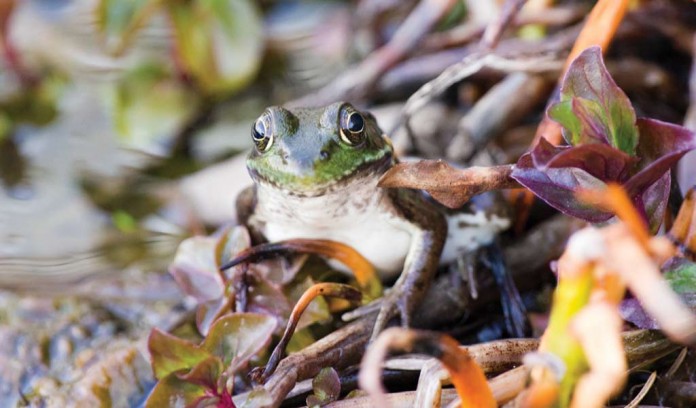If you’ve ever doubted that water is the wellspring of life, pay attention the next time it rains. Birds flock to puddles and birdbaths to drink and bathe. Box turtles become active and can be seen crossing roads.
Drive slowly on back roads at night to see a steady parade of frogs and toads. And every now and then, a mysterious, brightly colored creature appears in backyards. It happened at our house last Monday.
“There’s one of those bright orange salamanders on the front walk,” my wife informed me.
Unusual discovery
Sure enough, I found a 3-inch-long, red eft making its way across a large flat rock that leads to the porch steps.
“Eft” may be a new vocabulary word, and if nothing else, it’s a great Scrabble word. An eft is the terrestrial larval stage of the aquatic eastern or red-spotted newt. Red-spotted newts are common amphibians found in ponds, shallow lakes, marshes and quiet stretches of small streams throughout eastern North America. Populations tend to be highest where aquatic vegetation is abundant.
Unlike frogs and toads, which most people recognize as amphibians whose life history includes a three-stage complete metamorphosis (egg, tadpole, adult), some salamanders add a fourth stage to the life cycle.
Beginnings
Red-spotted newts begin life as an egg, which females lay individually and attach to aquatic vegetation. Each female lays just a few eggs each day, but the breeding season can last for several months.
After hatching, the tiny larva lives for several months in water and breathes via gills. These tiny larval newts eat even smaller invertebrates. By late summer, these aquatic larvae transform into terrestrial red efts.
They live on the land for one-to-four years, before returning to a wetland and transforming into a fully aquatic newt. Adult newts have gills and usually live in water, but they can move to land and live under leaf litter during dry spells and even hibernate on land during winter.
Red efts and adult newts often return to the home ponds where they were born. A keen sense of smell and an innate magnetic compass equip them with a strong homing instinct. If adults are displaced from the ponds they were born in, they respond by orienting in the direction of their home ponds.
Body markings
The red eft stage is quite conspicuous and easy to recognize. It can measure up to three inches long and its bright reddish orange skin is marked by a row of black-bordered red spots that runs along both sides of the spine. And unlike most salamanders, a red eft’s skin is dry, course, and granular. The eft’s bright colors warn potential predators that taking a mouthful is distasteful, dangerous and possibly fatal.
The eft’s skin secretes a toxic substance that can sicken or even kill predators that might eat other types of salamanders. This is also why anglers should avoid using red efts as live bait.
Fish know better than to eat them. Because most amphibians require water to complete their life cycle, the terrestrial nature of a red eft’s life is remarkable.
After transforming to this land-based stage, efts can travel great distances over the next several years. For example, my house sits on top of a dry ridge. The nearest permanent water is more than a quarter mile away in valleys on either side of the ridge.
Getting to our yard represents an incredible journey for such a small creature. While on the move for several years, efts usually stay under the leaf litter, though they are often found walking on the forest floor in broad daylight.
Their bright warning colors protect them from hungry predators.
Dietary choices
Small insects, spiders, snails and slugs are among red efts’ favorite prey, though they will eat just about anything they can swallow. Aquatic adult newts add frog eggs, fairy shrimp, and mosquito larva to their diet.
Red-spotted newts live as red efts from one-to-four years. Field studies have shown that when the population is low, the red eft stage is shorter.
This adaptation enables a more rapid reproductive rate when the population is low.













